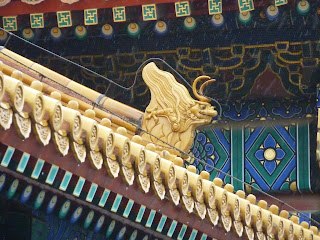9th June 2013 - It was a wet, miserable day in Beijing as I set off on my own to explore the Forbidden City. (How could one go all the way to Beijing and not go?)
Home to twenty four emperors of the Ming and Qing dynasties, there isan amazing uniformity to the
Zijin Cheng, quite unlike the
Topkapi at Istanbul, where each emperor added his eccentricity to the structure!
I've used the Chinese names for buildings, gates and halls. And so, "dian" seems to mean hall, "gong" palace and "men" gate. I find the whole Chinese-English translations unsatisfactory, and quite often comic . I wonder why they do it. We do not for example, translate Taj Mahal or Mount Kaliash or Kedarnath, so why should they?
 |
| The outer walls, to access the Wu men gate. |
 |
| The entrance into the complex is via these little bridges, as Mao looks on. |
 |
| The huge courtyard in front of the Wu Men Gate. This courtyard was used for a lot of royal events, so the emperor came I guess to that balcony above, and observed whatever he had to - royal decrees, prisoners of war, etc, and they did not enter the Forbidden City. Until this point, the entry is free. To go through the little "tunel" at the back into the complex is ticketed. |
 |
| There are five of these towers over the Gate - Wu feng Lou. This courtyard is basically over the moat that encircles the palace. |
 |
| We wandered out to see the moat, on the first day. Nobody comes here it seems, it was quiet and a nice place to sit and daydream! |
 |
| As the drizzle continued, I walked in to the Outer Court, and I just loved the Golden Water Bridges and the canals that were worked into this Outer Court. I pictured the royalty of old taking walks across these bridges, and enjoying the water flowing in these canals |
 |
| A Mallard waddled by in the water, which served as a reservoir and water supply as well (in times of seige I guess) for the complex. |
 |
| There are five such bridges, and this is the view towards the Taihe Men - Gate of Supreme Harmony of the Outer Court. A sea of umbrellas, as the rain refused to let up! Even with so many tourists thronging the place, the complex looked forbiddingly large. A pair of bronze lions sit on either side of the Gate. |
 |
| This is the lioness, with its paw on a cub, and from the Ming period. See the male from the Qing period here. |
 |
| Through the Taihen Men, and overlooking the huge Taihe Dian Square. It is a massive piece of empty real estate - 30,000 sqm I read somewhere! |
 |
| This Taihe Dian hall is one of the largest woodens structures in China, and sits atop a three-level marble base. |
 |
| A roof detail... |
As I took refuge from the rain under the eaves of this hall, my eyes were drawn to all the various little details in the decorations all over.
The beautifully painted roof and beams had an amazing collection of motifs and designs.
 |
| ...dragons on the beams |
 |
| ...and this was the underside of the eaves! |
In the large balcony of this hall are a motley collection of animal bronzes, grain measures, and even a sundial!
 |
| A pair of cranes for good luck.... |
 |
| ...the tortoise for (quite aptly) longevity..... |
 |
| ...and a sundial!! |
 |
| Zhonge Dian, where the emperor could rest (on his way from the back to the front?!) |
 |
| And here's where he rested. |
 |
| The Baohe Dian throne. (He changed his clothes here, the Emperor I mean before some grand ceremonies.) The Chinese running full length is a couplet written by Emperor Qianlong. |
More dragons everywhere....
 |
| Qianqing Gong, with a few of the 308 copper vats that are strewn across the campus, which were the equivalent of fire hydrants for the wooden palace structures. |
Eaves, roofs and more details
 |
| My favourite English translation. From the time of Emperor Yngzheng, the third Qing emperor, this hall attained significance as the living quarters of the incumbent. I wonder what would be a more apt translation of Yangxin. |
The Imperial Garden to the rear/north gate
 |
| Mosaics on the floor |
 |
| More ornate eaves |
 |
| The northern (exit) gate. Jingshan Park ahead. So you get out, very far away from where you got in! |
 |
| The massive moat surrounding the complex is more evident this northern side. |
I went all around the complex, left on Jingshan Street and walked all the way down Beichang street. This is a very tony neighbourhood by the way, and it was an enjoyable walk in the rain, as I made my way to Tiananmen West station and back to the hotel.
Maybe it was the weather or the fact that I was on my own, but the
Forbidden City left me cold (and wet!!) and kind of unimpressed.





































































Come October, and season begins in Gir, the home of the fabulous Asiatic lion. Zerin Anklesaria was there recently and, thankfully, lived to tell the tale.